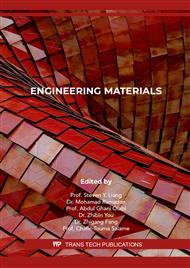[1]
K.K. Alaneme, E.A. Okotete, Recrystallization mechanisms and microstructure development in emerging metallic materials: A review, J. Sci.-Adv. Mater. Dev. 4 (2019) 19-33.
DOI: 10.1016/j.jsamd.2018.12.007
Google Scholar
[2]
P. Hirsch, 50 Years of transmission electron microscopy of dislocations: Past, present, and future, Her. Russ. Acad. Sci. 76 (2006) 430-436.
DOI: 10.1134/s1019331606050042
Google Scholar
[3]
J. Lin, Fundamentals of materials modelling for metals processing technologies: theories and applications. World Scientific Publishing Company, (2015).
Google Scholar
[4]
Q. Zhang, X. Luan, S. Dhawan, D.J. Politis, Q Du, M. Fu, K. Wang, M.M. Gharbi, L. Wang, Development of the post-form strength prediction model for a high-strength 6xxx aluminium alloy with pre-existing precipitates and residual dislocations, Int. J. Plast. 119 (2019) 230-248.
DOI: 10.1016/j.ijplas.2019.03.013
Google Scholar
[5]
Y. Li, B.Gu, S. Jiang, Y. Liu, Z. Shi, J. Lin,. A CDRX-based material model for hot deformation of aluminium alloys, Int. J. Plast. 134 (2020), 102844.
DOI: 10.1016/j.ijplas.2020.102844
Google Scholar
[6]
A. Vinogradov, Y. Estrin, Analytical and numerical approaches to modelling severe plastic deformation, Prog. Mater. Sci. 95 (2018) 172-242.
DOI: 10.1016/j.pmatsci.2018.02.001
Google Scholar
[7]
C.M. Byer, K. Ramesh, Effects of the initial dislocation density on size effects in single-crystal magnesium, Acta Mater. 61 (2013) 3808-3818.
DOI: 10.1016/j.actamat.2013.03.019
Google Scholar
[8]
L.P. Kubin, A. Mortensen, Geometrically necessary dislocations and strain-gradient plasticity: a few critical issues, Scripta Mater. 48 (2003) 119-125.
DOI: 10.1016/s1359-6462(02)00335-4
Google Scholar
[9]
H. Gao, Y. Huang, W. Nix, and J. Hutchinson, Mechanism-based strain gradient plasticity-I. Theory, J. Mech. Phys. Solids 47 (1999) 1239-1263.
Google Scholar
[10]
E. Demir, D. Raabe, N. Zaafarani, and S. Zaefferer, Investigation of the indentation size effect through the measurement of the geometrically necessary dislocations beneath small indents of different depths using EBSD tomography, Acta Mater. 57 (2009) 559-569.
DOI: 10.1016/j.actamat.2008.09.039
Google Scholar
[11]
M. Ashby, The deformation of plastically non-homogeneous materials, The Philosophical Magazine: A Journal of Theoretical Experimental and Applied Physics. 21 (1970) 399-424.
DOI: 10.1080/14786437008238426
Google Scholar
[12]
J. Jiang, T. Britton, and A. Wilkinson, Measurement of geometrically necessary dislocation density with high resolution electron backscatter diffraction: effects of detector binning and step size, Ultramicroscopy. 125 (2013) 1-9.
DOI: 10.1016/j.ultramic.2012.11.003
Google Scholar
[13]
S. Kalácska, I. Groma, A. Borbély, and P.D. Ispánovity, Comparison of the dislocation density obtained by HR-EBSD and X-ray profile analysis, Appl. Phys. Lett. 110 (2017) 091912.
DOI: 10.1063/1.4977569
Google Scholar
[14]
W. Huo, L. Hou, Y. Lang, H. Cui, L. Zhuang, and J. Zhang, Improved thermo-mechanical processing for effective grain refinement of high-strength AA 7050 Al alloy, Mater. Sci. Eng. A. 626 (2015) 86-93.
DOI: 10.1016/j.msea.2014.12.071
Google Scholar
[15]
A. Cottrell, An introduction to metallurgy, second ed., CRC Press, New York, (2019).
Google Scholar
[16]
N. Han, X. Zhang, S. Liu, F. Song, and X. Xin, Influence of two-step aging on fracture toughness of 7050 aluminum alloy plate, J. Cent. South Univ. 42 (2011) 623-628.
Google Scholar
[17]
W. Pantleon, Resolving the geometrically necessary dislocation content by conventional electron backscattering diffraction, Scripta Mater. 58 (2008) 994-997.
DOI: 10.1016/j.scriptamat.2008.01.050
Google Scholar
[18]
F.J. Humphreys, Y. Huang, I. Brough, and C. Harris, Electron backscatter diffraction of grain and subgrain structures—resolution considerations, J. Microsc. 195 (1999) 212-216.
DOI: 10.1046/j.1365-2818.1999.00579.x
Google Scholar
[19]
H.J. Frost and M.F. Ashby, Deformation-mechanism maps: the plasticity and creep of metals and ceramics, Pergamon Press, New York, (1982).
Google Scholar


